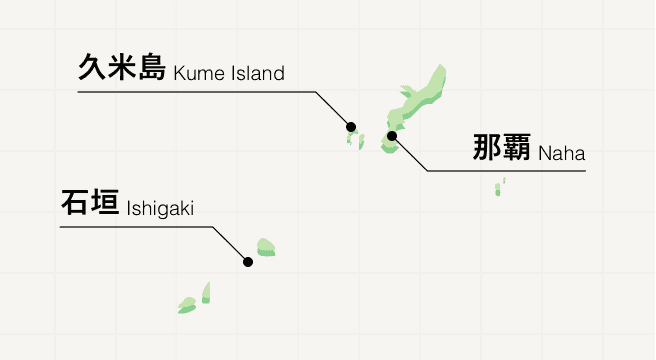Historical Monument Spots in Naha / Shuri Area
Area
-
-
Okinawa
-
-
Okinawa

Category


-
- Shurijo Castle Park (Shurijo Castle)
-
4.0205 Reviews
- Leisure / Hobbies
- Okinawa Pref. Nahashi Shurikinjouchou 1-2
-
Beautiful castle, lucky to be still standing after multiple fires over the centuries. There were dancers/entertainment in the grounds when we were there. A couple of gift shops and a cafe...
-
- The Former Japanese Navy Underground Headquarters
-
4.5418 Reviews
- Travel / Tourism
- Okinawa Pref. Tomigusukushi Tomigusuku 236
- The Former Japanese Navy Underground Headquarters is an underground bunker complex constructed in 1944. There were around 450 meters of tunnels in total; the aim was to enable the defense of Okinawa to be carried on for as long as possible. The underground complex held a total of around 4,000 personnel; many lives were lost here. In 1970, 300 meters of the tunnels (including the command center) were restored, and opened to the public. There is a museum with a display of items recovered from the underground bunker complex, including weapons, uniforms, letters written to family members, etc.
-
Was o.k., but (my opinion) painted a horrible picture of the U.S. during the war when in fact mainland Japan didnt exactly treat the Okinwans as equals during this time.
-
- Shureimon Gate
- Travel / Tourism
- Okinawa prefecture Naha city Shuri Shuri Castle Park
- “Shurei” means “observing manners” and “a nation which observes manners” is written on the horizontal frame at the center of Shureimon Gate. It means “Ryukyu is a nation which respects manners”. It is a beautiful gate representing Shuri Castle which is a World Heritage site and was built around 1527 to 1555. It was destroyed during the Pacific War but restored later in 1958.
-
- Kankaimon Gate
- Travel / Tourism
- Okinawa prefecture Naha city Shuri Shuri Castle Park
- Kankaimon Gate was the main entrance to Shuri-jo Castle (a UNESCO World Heritage Site). This was the entrance through which “Sakuhoshi”, (Chinese envoys, also known as “Sapposhi”) would pass when granted an audience with the Ryukyuan King; the name “Kankaimon” (“Gate of Welcome”) reflects this. The Gate was destroyed by fire during the Second World War, but was rebuilt in 1974. Shisa statues stand on either side of the Gate to ward off evil spirits.
-
- Sonohyan Utaki Stone Gate
- Travel / Tourism
- Okinawa prefecture Naha city Shuri Shuri Castle Park
- Sonohyan Utaki Stone Gate made from Ryukyu limestone is a place of worship where the emperor used to pray for his safety when going out. During the Pacific War, a part of the building was destroyed, but it was restored in 1957. In 2000, it was designated as a World Heritage Site. Though it is in the shape of a gate, it is not for people to walk through but is more of a “gate for worship” to God.
-
- Benzaitendo House and Enkanchi Pond
- Travel / Tourism
- Okinawa prefecture Naha city Shuri Shuri Castle Park
- Benzaitendo House and Enkanchi Pond are cultural properties located inside the Shuri Castle Park in Naha City, Okinawa Prefecture. Enkanchi Pond is a manmade pond which was built in 1502 to collect spring water and rainwater within Shuri Castle. Benzaitendo is a red-roofed shrine located in the middle of Enkanchi Pond which enshrines Benzaiten, a water goddess controlling safe sea voyages.
-
- Old Sogen-ji Temple, Stone Wall
- Travel / Tourism
- Okinawa Naha-shi Tomari 1-9-1
- This historical structure is located in Tomari 1-Chome, Naha City. It is an arched stone gate remaining in the ruins of Sogen-ji Temple, which was a national mausoleum where the spirits of each generation of Ryukyu Kingdom were venerated. It is designated as a National Important Cultural Property. During the Ryukyu Kingdom period, the ceremony for venerating the previous king before a new king was coronated was performed at Sogen-ji Temple.
Okinawa Areas

Let go of your image of a busy, ordered Japan and replace it with crystal-clear waters, white sand beaches, and relaxing folk music: You’ve arrived in Okinawa. A world away from the high intensity of Tokyo, Okinawans appear to live a laid-back beach life on this paradisiacal tropical island that lies in the middle of the East China Sea almost 1,000 kilometers south of mainland Japan’s most southern tip. Home to a spattering of islands, prepare yourself to discover underwater caves, star-shaped sand, and an island culture sometimes unrecognizable from mainland Japan.
Best of Okinawa
Search by Region
-
- Hokkaido / Tohoku
- Hokkaido
- Aomori
- Iwate
- Miyagi
- Akita
- Yamagata
- Fukushima
-
- Kanto
- Ibaraki
- Tochigi
- Gunma
- Saitama
- Chiba
- Tokyo
- Kanagawa
-
- Koshinetsu / Hokuriku
- Niigata
- Toyama
- Ishikawa
- Fukui
- Yamanashi
- Nagano
-
- Tokai
- Gifu
- Shizuoka
- Aichi
- Mie
-
- Kinki
- Shiga
- Kyoto
- Osaka
- Hyogo
- Nara
- Wakayama
-
- Chugoku
- Tottori
- Shimane
- Okayama
- Hiroshima
- Yamaguchi
-
- Shikoku
- Tokushima
- Kagawa
- Ehime
- Kochi
-
- Kyushu / Okinawa
- Fukuoka
- Saga
- Nagasaki
- Kumamoto
- Oita
- Miyazaki
- Kagoshima
- Okinawa




















